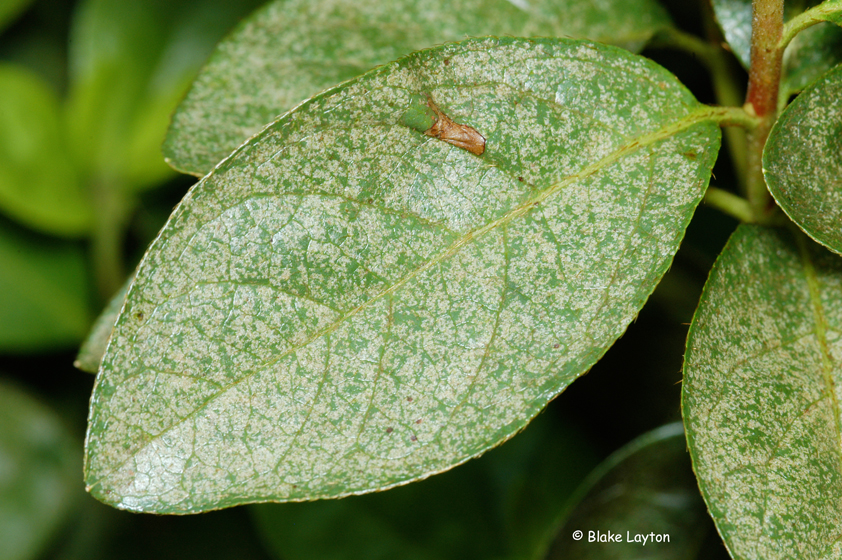Azalea Lace Bug Symptoms | Vol. 3, No. 2

Stephanitis pyrioides
Order: Hemiptera
Family: Tingidae
On most plants, this type of stippled appearance on the leaves is a sign of spider mite infestation, but on azaleas, stippled leaves are usually a sign of azalea lace bugs. Lace bugs are the most common insect pest of azaleas and heavy infestations can cause leaves to appear bronzed or “bleached out,” resulting in poor growth and reduced bloom. Most plantings of azaleas will harbor a few lace bugs, but heavy infestations can cause plants to be unsightly. Azaleas that are stressed or growing in full sun are more likely to suffer heavy infestations than plants growing in filtered shade, and some varieties are more susceptible than others.
Lace bugs overwinter as eggs, inserted in the leaves. Nymphs do not appear until early spring, but it is easy to diagnose lace bug infestations any time of year by checking the undersides of leaves for the dark fecal deposits these insects leave behind.
Control: For fast-acting control of heavy lace bug infestations spray with a foliar-applied systemic insecticide such as acephate (Bonide Systemic Insect Control) or imidacloprid + cyfluthrin (Bayer Complete Insect Killer). For long-lasting preventive control, use a soil-applied systemic treatment such as imidacloprid (Bayer Tree and Shrub Insect Control) or dinotefuran (Greenlight Tree and Shrub Insect Control). For best control of severe infestations do both; spray with acephate and apply a soil treatment of imidacloprid or dinotefuran. Avoid applying foliar sprays to azaleas when open flowers are present in order to protect pollinators such as bumble bees.
See Extension Publication 2369, Insect Pests of Ornamental Plants in the Home Landscape, page 17 and pages 35-36 for more information.
Blake Layton, Extension Entomology Specialist, Mississippi State University Extension Service.
The information given here is for educational purposes only. Always read and follow current label directions. Specific commercial products are mentioned as examples only and reference to specific products or trade names is made with the understanding that no discrimination is intended to other products that may also be suitable and appropriately labeled.
Sign up to receive Bug's Eye View.

